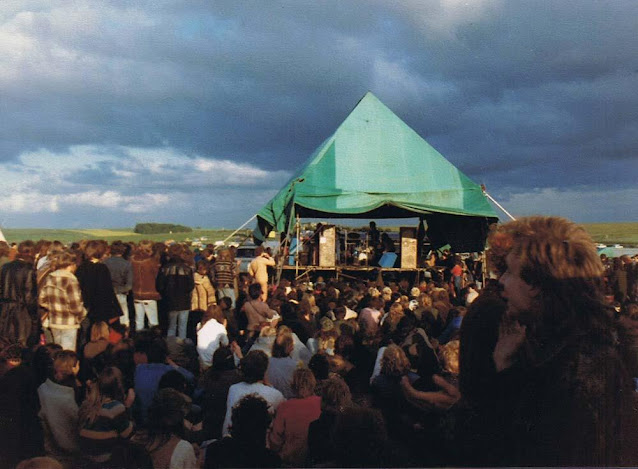THE STONEHENGE
RAMPAGE
That summer of 1980,
in an entirely different corner of society another smaller yet far
more grievous riot of sorts took place, this time out on the
Wiltshire plains at the annual Stonehenge Free Festival.
Unbeknownst to their
burgeoning audience at that time, members of Crass had been seminal
to the setting up of the first Stonehenge festival in 1974. From it
beginning as a gathering of a few hundred hippies in those early
days, it had steadily grown and developed into an absolutely unique
cultural phenomenon that by 1980 was attracting thousands. The
Stonehenge festival was an example of freedom in the raw where
practically anything was allowed due to the total lack of police
presence. Standing like a post-apocalyptic shanty town where the
music was free (courtesy of Hawkwind et al), the food was cheap or
even free (courtesy of the Hari Krishnas), and the drugs were in
abundance; it was a glimpse into how anarchy might - or might not -
work.
Crass had played at
the festival the previous year but on returning that following
summer, due to their rising popularity they had attracted a large
number of Punk Rockers to the site. Though Punk had moved on somewhat
from the days of Sex Pistols-type outrage, to some, Punk still
represented a challenge that was difficult to come to grips with.
Teddy Boys, of course, were famously known for their dislike of Punk
but unexpectedly there seemed to be certain bikers who also shared
that disdain.
From its outset,
Stonehenge was a predominantly hippy affair but as it grew so did the
composition of its attendees, pulling in all kinds of people from
different sections of society including straight-dressed kids from
council estates (taking full advantage of the drugs sold openly
there) and chapters of bikers (taking full advantage of the drugs
also, of course). The council estate kids were fine and treated the
festival like a narco Butlins so were simply there for a good time
(and all the rest was propaganda) but a lot of the bikers seemed to
have something to prove. Arriving on site usually in convoys, they
would park up in circles and claim areas of the site as their own.
Which was fine - anything that made them happy. Some, however, would
claim the whole festival as their own and it was these who didn't
take too kindly to what they saw that year as a Punk invasion.
Throwing bottles at
Punk band The Epileptics was the first sign of their displeasure,
which then quickly escalated to them seeking out and attacking any
Punk Rocker they could find. The ensuing violence was brutal and
frightening.
'Bikers Riot at
Stonehenge' read the headline in the following week's NME though in
truth it was more of a mindless rampage. The incident, however,
convinced Crass to decide never to play Stonehenge or any other free
festival again, which was really unfortunate. Nevertheless, by Crass
being there at all a chain reaction had started and the floodgates
were now opened. The budding Anarcho Punk culture had met
face-to-face with free festival culture - causing a mutation in both.
The year 1976 and
the advent of Punk is often cited as Year Zero. For some, this is
undoubtedly the case but at the same time, Punk - and in particular
the Sex Pistols - opened up the past and shone a light upon a
veritable treasure trove of reference points and influences: The New
York Dolls, Iggy Pop, the Velvet Underground, Patti Smith, the MC5,
Captain Beefheart, Dr Feelgood, The Doors, The Who, Alice Cooper, the
Situationists, King Mob, nihilism, anarchy, the mythology of the
Berlin Wall and the Chelsea Hotel, Paris '68, Dickensian London,
amphetamines... and heroin.
Likewise, Crass also
illuminated a plethora of references, ideas, influences and
possibilities; many intentionally but others not so: John Lennon,
Walt Whitman, RD Laing, Jack Kerouac, Allen Ginsberg, Sartre, Arthur
Rimbaud, Baudellaire, George Orwell, Richard Hamilton, John
Heartfield, Wilfred Owen, anarchism, pacifism, feminism, atheism,
existentialism, pop art, collage, Dada, graffiti, CND, black clothes,
squatting, free festivals, hashish... and LSD.
All links in a
chain. All important stepping stones to an ultimate yet unknown
destination.
Worlds were
colliding - be they political, social or cultural - causing
metamorphosis, unification, friction and (as at Stonehenge) sometimes
outright conflict.
It was the dawn of a
new decade and as events unfurled in St Paul's in Bristol and at the
Stonehenge Free Festival, less significantly (or perhaps more so?)
the music charts were being assailed by such classic bands as The
Jam, Dexy's Midnight Runners, and The Specials. It was Crass,
however, who were arguably becoming the most important band in
Britain due not only to their own records but also to the records
they were releasing by other artists on their label...

Ah...
ReplyDeleteI think I mentioned it over at my place, but I was at the '79 one, with the Epileptics, who didn't play in the end... it all went pear-shaped... and a bit of a story there! But the atmosphere wasn't great, it felt like there was just this undercurrent of violence, like it could all spill out of control at any moment. And of course the following year it did - I'm relieved I wasn't there for that.
But you're so right.. a chain reaction had started.